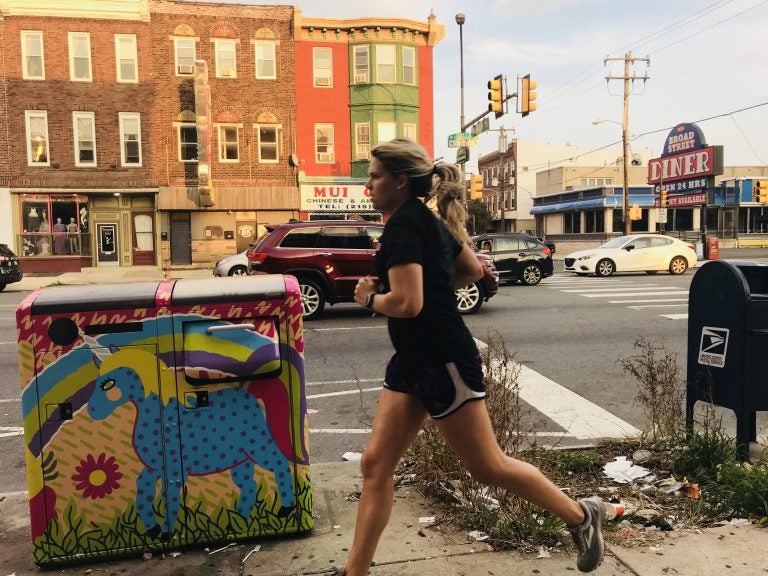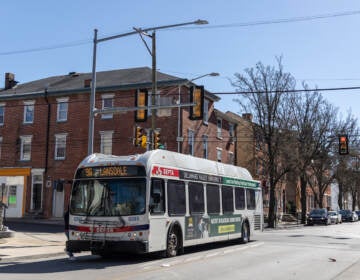With no cash for trash, city mulls partnerships with private groups
Fewer public trash cans result in more litter on streets and in parks.

A woman runs past a pile of litter next to a Big Belly trash can on South Broad Street. (Ariella Cohen/WHYY)
This story originally appeared on PlanPhilly.
—
Fewer public trash cans result in more litter on streets and in parks. That was the conclusion of a nine-month studydone by city officials working with researchers from the University of Pennsylvania, Temple University, and Swarthmore College. But while the study— as well as the intuition of many Filthadelphians — points to a need for more public trash cans, city officials have no definite plans to roll out more trash cans, or request more money for waste bins in next year’s budget.
“This will be among the many important priorities that will be considered in the coming budget deliberations,” city spokesman Mike Dunn said in an email.
Zero Waste and Litter Cabinet Director Nic Esposito said the study will help him make the case within City Hall for more spending on trash cans. In the meantime, neighborhood residents that want to see cleaner streets sooner rather may want to start fundraising. The Zero Waste and Litter Cabinet plans to soon roll out a new initiative that will encourage community groups to team up with the city and share expenses, Esposito said.
“I can’t promise that we’re going to be putting cans [this fall],” said Esposito.“I can promise that we are going to be coming up with a program where we can work with people and with community organizations and the city to have more trash cans.”
Such a program would reflect a trend towards public-private partnerships across Philadelphia. Already, many business districts and well-organized, affluent neighborhoods pay for increased cleanup services.
In the concluding pages of the study, the authors recommend using their research to “justify an expansion” of an existing “adopt-a-receptacle” program beyond block captains.
While the findings may sound like common sense, researchers said the question of whether adding or removing trash cans reduces or increases the amount of litter and the amount of time spent by staff cleaning it up had until now never been answered in a quantifiable way. According to the study, “some city departments feel that removing receptacles will prevent household trash dumping and force people to either hold onto their trash or waste less.”
“There was no evidence,” said Dan Hopkins, a political science professor at the University of Pennsylvania and collaborator of the study. “This is the kind of question that probably falls between the cracks; the kind of question that cities and municipalities are desperate to know the answer to, but that researchers would rarely have the capacity or interest to pursue.”
Hopkins said he was not surprised with the results, but that doesn’t mean testing it was worthless because even in cases where you have a strong intuition, sometimes an experiment can prove you wrong.
Recently, the New York City Sanitation Department removed 223 trash cans from Harlem because residents were using them to deposit their trash bags. And, as the city’s sanitation commissioner told the New York Times, the measure has been effective and the amount of trash on the street has been reduced.
But in Philly, it’s exactly the opposite. When the city removed trash cans from commercial corridors and parks, Philadelphians tended to drop their litter on the ground. The lack of trash cans resulted in higher costs for the city in staff hours required to clean a site.
On the other hand, when more trash cans were added, researchers didn’t necessarily see the amount of trash increase due to dumping.
A second study tested the effect of distributing lidded recycling bins to prevent litter and increase the amount of recycled tonnage, but the results were inconclusive.
The studies didn’t cost the city anything other than staff time, according to GovLabPHL Director Anjali Chainani. “No external actors were paid, and no grants were used,” Chainani wrote in an email. GovLabPHL, an initiative launched by Kenney, partners with universities on research that can inform city policy.
“The Zero Waste and Litter Cabinet has a number of goals, and we wanted to offer a way for them to measure if their pilots and efforts actually have an impact and how much of an impact,” Chaniani said. “Even marginal gains in evidence of what worked, and what didn’t, gives us more confidence in what next steps to take and how to further allocate the very limited resources we have.”
The city spent upwards of $5.6 million out of the city’s $4.4 billion budget to service wire wastebaskets in FY 2018, Dunn said. More than $2.8 million went towards servicing the Big Bellys found in Center City and other dense commercial areas. These figures don’t account for the money spent by the Department of Parks and Rec to maintain the cans on park property.
The hard cost of a new wire bin represents only teeny part of the cost — $100 per can. The Big Bellys cost $3,200 each, or $3,500 if a recycler is attached. The metal baskets take crews twice as long to service than Big Bellys, Dunn said.
The Zero Waste and Litter Cabinet has a budget of about $105,000, only large enough to cover salaries for Esposito and a staffer.
WHYY is your source for fact-based, in-depth journalism and information. As a nonprofit organization, we rely on financial support from readers like you. Please give today.







